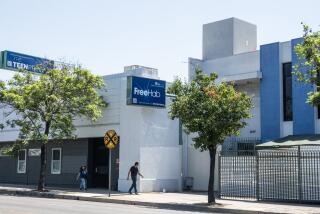Ex-Patient Recalls Grim Life in Clinic
Pedro Lopez awoke from a four-day bender and needed a drink. He reached for the door and pushed it open, only then realizing that he was in the back seat of a car speeding down the Hollywood Freeway.
His daughter, 17, held him back and pulled the car door shut. His wife kept driving.
She was on her way to the one place she believed her husband could be cured of the binge drinking that once again threatened to destroy their family. After a few minutes, Rosa Lopez pulled into a storefront rehabilitation center near downtown called Vida Nueva, or New Life. There, sleeping in a cramped room with cockroaches, rats and 60 people, Pedro Lopez would once again try to conquer the habit that had ruled him for most of his life.
Lopez, who spent eight weeks at Vida Nueva Alcoholicos Anonimos, offered a vivid account of grim life in the facility where a man died last year, allegedly after being tied up and force-fed alcohol in an âaversion therapyâ program meant to expunge his urge to drink.
In addition to that death, Los Angeles police are investigating at least seven other incidents at similar unlicensed rehabilitation facilities, including those of three men at Grupo Liberacion y Fortaleza in North Hollywood, where a man was found dead last month. County Health Department officials last week sent an advisory to county courts warning them not to allow defendants to serve alcohol or drug rehabilitation sentences at any of several dozen facilities that may be engaging in aversion therapy.
County Supervisors Zev Yaroslavsky and Mike Antonovich plan to ask for an update from law enforcement and health officials at todayâs meeting of the county Board of Supervisors.
Lopez, 48, arrived at Vida Nueva on April 16, 1997.
He said he was essentially a prisoner at the rehab center, but that he was never tied up because he never tried to escape. He said he was given alcohol about every four hours during the first few days to ease him through âthe shakesâ of withdrawal. But he was never forced to drink like those in the aversion program.
On his first day, Lopez said, he was taken to a room containing about 20 mattresses. Three people were assigned to each of the beds, which were soiled with urine and vomit, and were not cleaned in the more than 60 days he spent in the facility, Lopez said.
âThen they asked me, âYou want a drink?â â Lopez recalled. âI said, âYes.â â
He said he was given a shot of vodka. Two hours later, nervous and vomiting, Lopez said he asked for another. Again, he was given a shot. But this time he first had to eat a bowl of soup.
For the next three days, he said, he was given a drink every four hours, but only after eating a bowl of soup.
After the initial three days of treatment, Lopez said, patients were told to extend their arms and hold them flat and steady, palms down, in front of one or more of the group leaders.
If their hands trembled, they were sent back to the mattress room for at least another day. If not, they were given a shot of alcohol, allowed to take a shower and moved into the second phase of their recovery.
Lopez said his hands were steady, thus beginning three more days in the mattress room, this time without alcohol.
Also off-limits were coffee, soda, cigarettes, sugar and even water. The only thing he was allowed to drink was tea.
After the second three days, he was allowed to begin attending meetings in the evening. He could smoke again, and have a cup of coffee. Lopez said he stayed for another two months, recovering âlittle by little.â
In the two months Lopez was at the center, he said, two people became so ill that they were rushed to the hospital. Both died, he said.
Representatives of Vida Nueva were unavailable to comment Monday. But LAPD Sgt. Mike Coffey said Lopezâs description matched those of others who had gone through the program at Grupo Liberacion.
Lopez now works as a mechanic in Sun Valley. He said he has not had a drink since June 18, 1997.
Whatever pain he suffered in the process of drying out was worth it, he said. âRight now, you offer me a beer . . . I donât want a beer,â he said. âI donât need one.â
More to Read
Sign up for Essential California
The most important California stories and recommendations in your inbox every morning.
You may occasionally receive promotional content from the Los Angeles Times.











